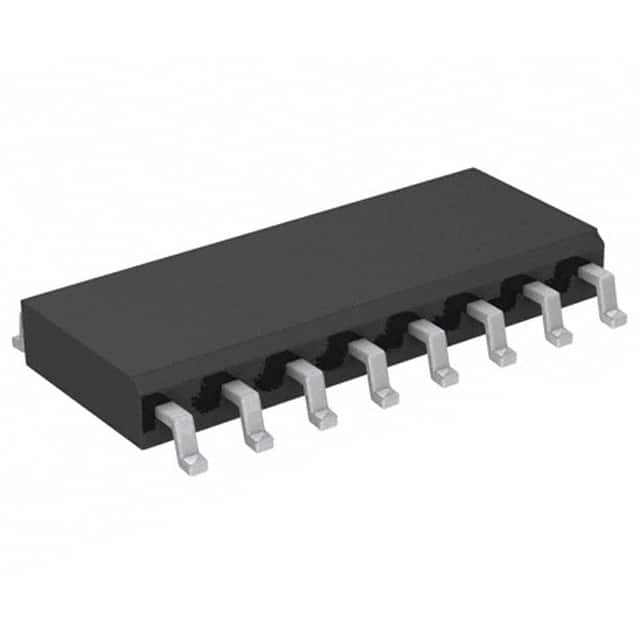74HCT4851D-Q100,11
Basic Information Overview
- Category: Integrated Circuit (IC)
- Use: Multiplexer/Demultiplexer
- Characteristics: High-speed CMOS logic, low power consumption
- Package: SOIC (Small Outline Integrated Circuit)
- Essence: Analog multiplexer/demultiplexer with digital control
- Packaging/Quantity: Tape and Reel, 2500 units per reel
Specifications
- Supply Voltage Range: 2.0V to 6.0V
- On-state Resistance: 80Ω (typical)
- Number of Channels: 8
- Input Signal Range: GND to VCC
- Output Signal Range: GND to VCC
- Operating Temperature Range: -40°C to +125°C
Detailed Pin Configuration
- S0: Channel Selection Input
- S1: Channel Selection Input
- S2: Channel Selection Input
- E: Enable Input
- Y0: Multiplexer Output
- Y1: Multiplexer Output
- Y2: Multiplexer Output
- Y3: Multiplexer Output
- Y4: Multiplexer Output
- Y5: Multiplexer Output
- Y6: Multiplexer Output
- Y7: Multiplexer Output
- GND: Ground
- VCC: Power Supply
Functional Features
- Analog multiplexing and demultiplexing of eight channels
- Digital control for channel selection using three input pins (S0, S1, S2)
- Enable pin (E) to activate or deactivate the device
- Low power consumption due to CMOS technology
- High-speed operation suitable for various applications
Advantages
- Wide supply voltage range allows compatibility with different systems
- Low on-state resistance ensures minimal signal distortion
- Compact SOIC package enables space-saving PCB design
- High-speed CMOS logic provides fast switching times
Disadvantages
- Limited number of channels (8) may not be sufficient for certain applications requiring more inputs/outputs
- Lack of built-in protection features against overvoltage or ESD events
Working Principles
The 74HCT4851D-Q100,11 is an analog multiplexer/demultiplexer IC that operates based on digital control signals. The three channel selection input pins (S0, S1, S2) determine the active channel, while the enable pin (E) activates or deactivates the device. When a specific channel is selected, the corresponding multiplexer output pin (Y0-Y7) carries the analog signal from the input to the output. The IC utilizes high-speed CMOS logic, ensuring fast and accurate signal transmission.
Detailed Application Field Plans
The 74HCT4851D-Q100,11 finds application in various fields where analog multiplexing or demultiplexing is required. Some potential areas of use include: 1. Data acquisition systems 2. Audio/video signal routing 3. Communication equipment 4. Industrial automation 5. Test and measurement instruments
Detailed and Complete Alternative Models
- CD4051B: Analog Multiplexer/Demultiplexer, 8 Channels, DIP Package
- SN74HC151: 8-to-1 Analog Multiplexer/Demultiplexer, SOIC Package
- ADG508F: CMOS Analog Multiplexer, 8 Channels, LFCSP Package
- MAX4617: Low-Voltage, Single-Supply Analog Multiplexer, TSSOP Package
- DG408DJ: Precision Monolithic Quad SPST CMOS Analog Switch, PDIP Package
Note: This is not an exhaustive list, and there are several other alternative models available in the market.
Word count: 413 words
Senaraikan 10 soalan dan jawapan biasa yang berkaitan dengan aplikasi 74HCT4851D-Q100,11 dalam penyelesaian teknikal
Sure! Here are 10 common questions and answers related to the application of 74HCT4851D-Q100,11 in technical solutions:
Q1: What is the 74HCT4851D-Q100,11? A1: The 74HCT4851D-Q100,11 is a high-speed CMOS analog multiplexer/demultiplexer IC with 8 channels. It allows for the selection of one of eight inputs to be routed to a single output.
Q2: What is the operating voltage range of the 74HCT4851D-Q100,11? A2: The operating voltage range is typically between 2V and 6V.
Q3: How does the 74HCT4851D-Q100,11 handle analog signals? A3: The 74HCT4851D-Q100,11 is designed to handle both analog and digital signals. It has low ON resistance and low crosstalk, making it suitable for analog applications.
Q4: Can the 74HCT4851D-Q100,11 be used as a multiplexer and demultiplexer? A4: Yes, the 74HCT4851D-Q100,11 can function as both a multiplexer and a demultiplexer. It can route multiple input signals to a single output or vice versa.
Q5: What is the maximum frequency at which the 74HCT4851D-Q100,11 can operate? A5: The 74HCT4851D-Q100,11 has a maximum operating frequency of around 125 MHz.
Q6: How many control pins does the 74HCT4851D-Q100,11 have? A6: The 74HCT4851D-Q100,11 has three control pins: S0, S1, and S2. These pins are used to select the desired input/output channel.
Q7: Can the 74HCT4851D-Q100,11 handle both digital and analog signals simultaneously? A7: Yes, the 74HCT4851D-Q100,11 can handle both digital and analog signals simultaneously. It is designed to be versatile in its application.
Q8: What is the typical ON resistance of the 74HCT4851D-Q100,11? A8: The typical ON resistance of the 74HCT4851D-Q100,11 is around 70 ohms.
Q9: Is the 74HCT4851D-Q100,11 suitable for automotive applications? A9: Yes, the 74HCT4851D-Q100,11 is specifically designed for automotive applications and is qualified according to the AEC-Q100 standard.
Q10: Can the 74HCT4851D-Q100,11 be cascaded to increase the number of channels? A10: Yes, multiple 74HCT4851D-Q100,11 ICs can be cascaded together to increase the number of channels available for selection.
Please note that these answers are general and may vary depending on specific datasheet specifications and application requirements.


